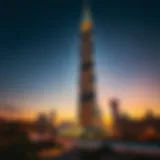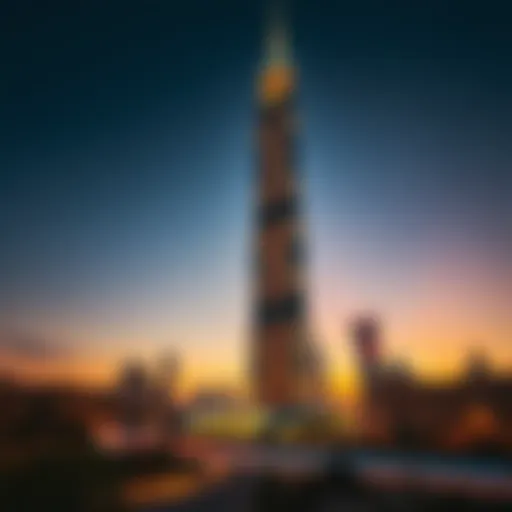Fountains of Dubai: Architectural Marvels and Culture
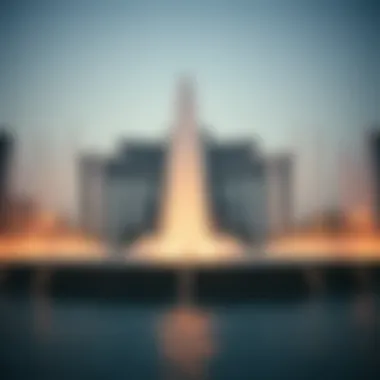

Intro
Dubai, a city synonymous with opulence and innovation, showcases a tapestry of architectural marvels, among which its fountains stand out as pivotal elements of the urban scenery. From the breathtaking spectacle of the Burj Khalifa's light and water display to the serene simplicity of smaller water features sprinkled throughout the city, these fountains are not merely for aesthetic pleasure; they carry profound cultural and historical significance. In the heart of a thriving metropolis, they weave a narrative that intertwines heritage with modernity.
This analysis will take a closer look at various fountains throughout Dubai, examining their distinct architectural styles and the community events that have shaped their journeys. We’ll discuss how these water features are both a reflection of Dubai's rich past and a symbol of its ambitious future, each one contributing uniquely to the city's identity.
Market Trends and Insights
Current Market Conditions
The development of fountains in Dubai is more than just an artistic endeavor; it is an investment in the city’s public landscape. Current conditions reveal that many of these water features are designed with sustainability in mind, addressing the needs of an ever-growing population while also being environmentally conscious. As the demand for public spaces increases, local authorities invest in the enhancement of these attractions to stimulate tourism and community engagement.
Particularly in areas such as Downtown Dubai and the waterfront of Dubai Marina, fountain installations demonstrate a balance of luxury and accessibility. Properties near these iconic fountains tend to hold their value well, attracting buyers and investors looking for prime real estate opportunities.
Future Predictions and Projections
As we look ahead, several trends emerge:
- Sustainable Design: The emphasis on eco-friendly materials and technologies to manage water usage more effectively.
- Smart Features: Integration of digital technologies that allow for dynamic light shows and real-time interactions with visitors.
- Cultural Integrations: Continued collaborations with artists and designers to reflect the cultural mosaic of Dubai through innovative fountain designs.
Experts predict that as the city grows, more fountains will be developed, becoming not just water features but communal spaces where residents and tourists alike can gather for events and celebrations.
Cultural Significance
The fountains of Dubai are not just visually stunning; they also serve as cultural landmarks. Each fountain often carries a story, whether reflecting local history, celebrating a special event, or enhancing traditional narratives. For instance, the Dubai Fountain, located on the Burj Khalifa Lake, features performances set to music that span various cultural genres, attracting diverse audiences and creating a shared experience.
"Fountains are the soul of the city; they represent a rhythm of life that flows through the hearts of its people."
— Local Architect
Moreover, these water installations act as gathering spots during festivals or public celebrations, further reinforcing their role in community life and cultural expression.
Finale
In summation, the fountains of Dubai are significant not only for their visual appeal but for their broader contributions to the urban ecosystem and community engagement. As the city continuously evolves, these water features will undoubtedly play an essential role in shaping Dubai's cultural landscape, reflecting both its heritage and its aspirations for the future.
Prelims to the Fountains of Dubai
The fountains of Dubai embody a blend of beauty, innovation, and cultural significance. They are not mere embellishments of the skyline but spectacular features that enrich the urban environment. The importance of this topic lies in how these water features epitomize both the advancement of design and the maintenance of tradition. As both residents and visitors flock to these sights, their impact resonates beyond aesthetics. In an era where many cities are striving for identity and expression, Dubai’s fountains stand out as hallmarks of architectural prowess and cultural narrative.
The Role of Fountains in Urban Design
Fountains hold a prime position in urban design, functioning as focal points that draw the eye and create social interaction. They are spaces where people congregate, offering a much-needed respite from the bustling pace of city life. The placement of fountains can dictate urban flow and connectivity, contributing to a cohesive city aesthetic.
Many public spaces, such as parks or plazas, employ fountains to facilitate gathering. As visitors amble about, the sound of water creates a soothing atmosphere, subtly encouraging lingering and interaction. Furthermore, in a place like Dubai, where temperatures can soar, fountains provide not just visual pleasure but also a cooling effect. This interplay of function and design is crucial; it ensures that fountains are not just there to look pretty but to serve real communal purposes.
Key Considerations in Urban Fountain Placement:
- Accessibility: Ensuring that fountains are easy to approach and see.
- Integration: Creating harmony with other elements like seating, landscaping, or pathways.
- Cultural Relevance: Incorporating local traditions or themes into the fountain’s design.
Ultimately, the placement and design of fountains can influence how urban spaces are experienced, often proving to be a unifying feature within various contexts of city life.
Cultural Significance of Water Features
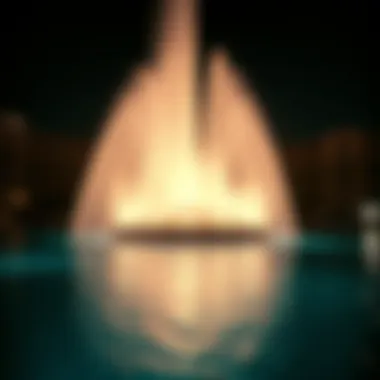

Water features have deep cultural symbolism across many societies, and in Dubai, this holds especially true. They are often seen as symbols of purity, life, and abundance. In a region historically characterized by arid landscapes, the presence of water becomes a celebration of ingenuity and prosperity. The incorporation of water elements in public spaces underscores the value placed on fluidity—whether that’s cultural exchange, social interaction, or natural resources.
Dubai's fountains do not merely splash water; they narrate stories. Each feature draws on the UAE's rich history, blending elements from both traditional and modern influences. For instance, the intricate designs found in many of these fountains mirror Islamic art, while their engineering marvels echo contemporary advancements.
Additionally, water-themed events and festivals often showcase these features, drawing international attention. This further cements their place not just locally but also on a global scale, enhancing Dubai's status as an innovative tourist destination.
The Burj Khalifa Fountains
The Burj Khalifa Fountains represent more than just a water show; they serve as a vital embodiment of Dubai's progressive vision and commitment to architectural excellence. As one stands in the pulsating heart of the city, gazing up at the world's tallest building, the fountains add a layer of dynamic interaction that mesmerizes both tourists and locals alike. The interplay of water and light symbolizes the fusion of art and technology, showcasing how Dubai marries innovative designs with its rich cultural tapestry. Such fountains draw significant interest from investors, homebuyers, and urban developers, highlighting the economic potential in integrating aesthetic beauty with urban planning.
Overview of the Burj Khalifa Fountain System
The fountain system at the Burj Khalifa, designed to compliment the architectural grandeur of the entire complex, extends over 275 meters in length. It features numerous jets that shoot water as high as 150 meters, creating a spectacle that can be viewed from several vantage points across the city. Each performance is choreographed to a variety of music styles, blending traditional Arabic tunes with modern international classics. What makes these fountains truly remarkable is not just the height of the water or the intricate choreography, but also the innovative technology that manages the entire display, ensuring fluid transitions and stunning visuals. Essentially, the Burj Khalifa's fountain system acts as a testament to how technology can enhance public art.
Technical Aspects of the Fountain Display
Delving into the technical details, the Burj Khalifa Fountains employ cutting-edge technology to produce their dazzling performances. The system consists of over 6,600 lights, paired with 50 colored projectors that illuminate the water, producing an impressive visual experience. The water itself is treated to maintain clarity and quality, ensuring that the viewer is not just awestruck by height but also by the clarity of the display.
Another noteworthy aspect is the precision in hydraulic engineering that allows for varied water sprays. Utilizing energy-efficient pumps reduces the overall environmental footprint. Each performance is controlled by a complex computer system, which ensures that timings, water flow, and illumination work in harmony, making every show a unique experience.
Chronology of the Performance Schedule
The Burj Khalifa Fountains have a well-coordinated schedule that captivates audiences throughout the day. Typically, performances occur every half hour in the evenings, starting from the late afternoon until midnight. Each show lasts approximately five minutes, featuring a harmonious blend of light, music, and the stunning choreography of water movement. This routine not only creates a spectacle for those who gather to watch but also gives opportunities for local businesses nearby, flourishing with the influx of tourists and residents alike.
The fountains have become a cultural landmark, drawing crowds and fostering community spirit in a dynamic urban environment.
In summary, the Burj Khalifa Fountains continue to enhance Dubai's identity as a global city, merging art with technology while enriching the communal experience. These features serve not just as entertainment, but as key elements of urban life, drawing interest from those invested in the future of Dubai's evolving skyline.
Dubai Fountain: Design and Engineering
Fountains serve not only as aesthetic enhancements but also embody the engineering prowess and architectural creativity integral to Dubai's urban landscape. The Dubai Fountain, specifically, stands as a testament to the local innovation in both design and functionality. As visitors flock to witness its dynamic displays, it raises pertinent points of how engineering techniques merge seamlessly with artistic vision, setting a benchmark in urban water features.
Architectural Vision Behind the Fountain
The architectural vision for the Dubai Fountain traces back to its creators’ ambition to create a truly unique spectacle that harmonizes water, light, and sound. The fountain stretches over 275 meters and features an impressive array of water jets that shot water as high as 150 meters into the air, making the structure a monumental piece of art.
Designed by WET Design, the same team behind the famed Fountains of Bellagio in Las Vegas, the goal was to ensure fluidity not just in movement but also in design. Each element of the fountain, from the uniform patterns of water jets to the synchronization of choreographed music, reflects a devotion to creating an experience that resonates with the cultural identity of Dubai. The choice of colors and patterns is intended to evoke the dunes of the desert while also providing an enchanting atmosphere.
"The Dubai Fountain showcases the wonderful marriage between technology and artistry while elevating the surroundings into something magical."
In the realm of architecture, the fountain embodies a remarkable blend of modern engineering and traditional stylistic elements. Each performance is a reminder of the capabilities of human ingenuity when applied to natural elements. Its dramatic showcases draw in crowds, elevating the surrounding area into a vibrant hub of activity.
Innovative Materials Used in Construction
A fountain of this magnitude requires materials that can withstand the test of time while maintaining aesthetic appeal. The Dubai Fountain employs a variety of innovative materials that are both functional and visually striking. The base is constructed from reinforced concrete, providing the necessary strength and durability to support the water feature. Incorporating lightweight glass and stone elements creates a modern contrast that accentuates the flowing water.
In consideration of operational efficiency, the fountain utilizes specialized nozzles engineered for high-precision water flow. This technology is not only vital for the fountain's choreographed displays, but it also limits water waste—an essential factor in a desert environment. Additionally, the automatic lighting system uses LED technology with low energy consumption, reinforcing the commitment to sustainability in urban planning.
Through a careful selection of materials, the Dubai Fountain exemplifies how thoughtful engineering can facilitate spectacular displays while considering environmental impacts. Materials used in the fountain construction serve as a bridge between the technological mastery of modernity and the age-old allure of water as a life-giving source.
For a deeper understanding of how urban water features influence city designs, you can reference materials from Wikipedia or explore architectural insights on Britannica for additional context.
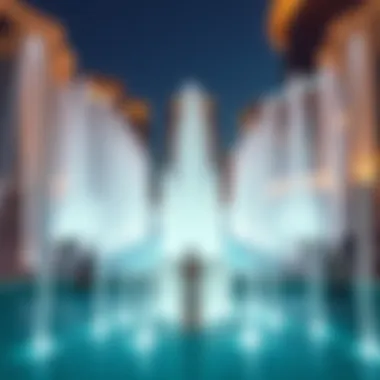

Al Qudra Lakes and Fountains
The Al Qudra Lakes are a hidden gem located in the Dubai desert, serving as an oasis that contrasts with the bustling urban landscape of the city. These lakes and their accompanying fountains not only showcase the remarkable engineering prowess of the region but also play a pivotal role in environmental conservation and community gathering. The topic of Al Qudra Lakes and Fountains in this article underscores their importance as both recreational areas and vital ecological zones that support various wildlife and contribute to the overall water landscape of Dubai.
Natural vs. Man-Made Water Features
In contrasting natural water bodies with man-made ones, Al Qudra Lakes begs a deeper exploration of how humans interact with the environment.
- Natural Features: These lakes, formed by the natural flow of water in an arid desert, provide essential habitats for migratory birds and other wildlife. Their formation relies on seasonal rains and aquifers, promoting ecological balance.
- Man-Made Features: The fountains built around Al Qudra enhance its aesthetic appeal, offering visitors a mesmerizing sight. These structures feature synchronized water displays and often utilize advanced technology to create various effects such as mist and lighting. However, they are also designed with sustainability in mind, using less water compared to traditional fountains.
By blending nature with technology, Al Qudra Lakes and Fountains become a prime example of how urban development and natural habitats can coexist harmoniously, providing a space for both leisure and ecological health.
Ecological Impact of Water Features
The ecological benefits of the Al Qudra Lakes extend far beyond their visual appeal.
"Water, as we know, is the essence of life, especially in desert environments."
The fountains and lakes contribute to local biodiversity by:
- Supporting Wildlife: The area attracts numerous species, including migratory birds such as flamingos, which find food and nesting sites in this unique ecosystem.
- Improving Air Quality: Evapotranspiration from water bodies helps moderate the local climate, lowering temperatures and improving air quality for nearby urban settlements.
- Conservation Efforts: The collaboration between designers, environmentalists, and city planners has led to initiatives that promote wildlife conservation, ensuring the area remains a vital green space amidst the concrete jungle of Dubai.
Overall, the Al Qudra Lakes and Fountains tell a rich story of sustainability, community engagement, and the intricate interplay between human creation and the natural environment. As such, they serve not just as a recreational area but also as a beacon of hope for future sustainable urban developments.
Community Interaction with Fountains
The fountains of Dubai do not merely serve as ornamental pieces but are vital components of the urban environment. They facilitate community interaction while fostering social cohesion and cultural exchange. From leisurely strolls near the water to vibrant public gatherings, these installations form a backdrop for experiences that unite diverse groups of people. Not only do they enhance the aesthetic quality of public spaces, but they also invite gatherings that create a sense of belonging among residents and visitors alike.
Public Gatherings and Events
Fountains in Dubai play an integral role in hosting various public gatherings and events, drawing large crowds eager to engage with their surroundings. During festivities, fountains often become focal points of celebration. For example, the Dubai Fountain at the base of the Burj Khalifa lights up not just the night sky but the spirits of people celebrating events such as National Day or New Year’s Eve. Families, friends, and strangers alike convene to enjoy stunning water displays synchronized to music, creating an electrifying atmosphere that brings people together.
The advantages of hosting events around these fountains are plentiful:
- Social Engagement: Fountains provide a venue for spontaneous or organized events, fostering connections among attendees.
- Economic Activity: They often attract local vendors, boosting the economy.
- Tourism Promotion: These gatherings entice tourists, showcasing Dubai's vibrancy and diversifying visitor experiences.
The accessibility of these public spaces ensures that individuals from all walks of life can participate, promoting inclusivity while enhancing the city’s identity. As people gather, they not only share moments of joy but also form collective memories, reinforcing community ties.
Religious and Cultural Celebrations
Fountains in Dubai are also intertwined with religious and cultural celebrations, offering a sacred space for observance. For example, during the holy month of Ramadan, certain fountains are adorned with special lighting that resonates with the festive spirit. These water features become venues for reflection and gathering, allowing community members to connect over shared beliefs and practices.
Religious events often see larger crowds at fountains where people congregate for prayers or cultural festivities, celebrating diversity through communal activities. The synchronization of water displays with traditional music can elevate the spiritual atmosphere and provide a mesmerizing backdrop that enhances the significance of these occasions.
Noteworthy aspects of fountains during these celebrations include:
- Symbolic Representation: Water often holds deep cultural and spiritual meanings, enhancing the significance of gatherings.
- Artistic Expression: Fountains can become canvases for artists, showcasing local talent during cultural events.
- Community Service: Many gatherings promote charitable causes, with fountains serving as meeting points for community outreach initiatives.
The marriages of art, technology, and tradition seen in these events catalyze cultural dialogue, creating an atmosphere where worship and celebration blend seamlessly. Through such interactions, Dubai's fountains continue to nurture community bonds, making them essential to the city’s social fabric.
Fountain Maintenance and Sustainability


Fountains are not just mere aesthetic features in urban designs; they embody engineering marvels that require diligent upkeep and sustainable practices to thrive. The fountains of Dubai exemplify this crucial aspect of urban landscapes. Maintaining these water features ensures their operational efficiency, making them a continuous source of beauty and delight for both locals and tourists. Effective maintenance strategies can also enhance the fountains' lifespan, optimizing investments made in their design and construction. Moreover, with rising environmental concerns, sustainable practices in fountain design are becoming increasingly salient. This section delves into the dual lanes of fountain maintenance and sustainability, dissecting the challenges faced and the innovative solutions adopted.
Challenges in Water Feature Maintenance
Keeping fountains in prime condition isn't as simple as one might think. Several challenges emerge when trying to maintain these water jewels:
- Water quality management: High temperatures in Dubai can accelerate algae growth, requiring rigorous water treatment and maintenance schedules. Regular water testing and chemical adjustments are non-negotiable.
- Mechanical malfunction: Pumps and nozzles, the heart of any fountain, can face breakdowns that require immediate attention. If not addressed timely, this could lead to significant downtimes affecting aesthetic appeal.
- Environmental damage: Sun exposure, wind, and dust accumulation can wear down surfaces and mechanical systems. Ensuring long-term resilience calls for consistent monitoring and repairs, which can be labor-intensive.
- Public interaction: While fountains are designed to attract crowds, the possibility of vandalism or misuse can lead to damage, requiring additional maintenance efforts.
Addressing these challenges is crucial for the sustained elegance and functionality of Dubai's fountains, but it often involves balancing costs with the need for frequent upkeep.
Sustainable Practices in Fountain Design
Sustainability is more than just a buzzword; it’s an essential aspect of modern fountain design and operation. Here are some sustainable practices that are making waves in Dubai:
- Water recycling systems: Modern fountains incorporate advanced water recycling technologies, allowing water to be treated and reused, thus conserving precious resources. Systems like these significantly reduce the amount of water needed for operation, especially in arid climates.
- Renewable energy utilization: Solar panels are finding a place in fountain operation, cutting down on energy costs and minimizing carbon footprints. Using solar energy to run pumps and lighting can lead to significant long-term savings.
- Eco-friendly materials: The selection of sustainable materials for construction not only reduces environmental impact but also enhances durability against the elements. Choosing materials like recycled glass and responsibly sourced stones can make a difference.
- Natural filtration: Some fountains are now designed with bio-filtration systems, allowing for natural purification of water through plant life, reducing the need for chemical treatments and promoting biodiversity.
Utilizing these sustainable practices not only aligns with global environmental standards but also enhances the city's image as a forward-thinking metropolis. An emphasis on maintenance and sustainability is vital to ensure that the fountains of Dubai remain not only a highlight of architectural beauty but also a model of responsible urban development.
"The future of fountain design lies not just in aesthetic appeal but in our commitment to environmental responsibility and innovation."
This emphasis on sustainable practices ensures the ongoing legacy of Dubai's fountains while addressing pressing global environmental challenges. It represents a step toward a future where urban beauty coexists harmoniously with ecological integrity.
Future Trends in Fountain Design
Exploring the future trends in fountain design is crucial for understanding how Dubai's urban landscape will continue to evolve. Fountains are not just decorative features; they play a significant role in enhancing public spaces and promoting environmental sustainability. As urban designers seek to marry functionality with aesthetics, the integration of new technologies and a focus on ecological considerations are becoming paramount.
Integration of Technology in Fountains
The fusion of technology and artistry is reshaping how fountains are conceived and experienced. The incorporation of smart sensors allows for responsive water displays that adapt to surrounding conditions. This means the water flow, color, and lighting can change based on weather patterns or the time of day, creating a dynamic visual experience. For instance, integrating LED lights programmed to project different colors or patterns can enhance the viewer’s experience exponentially.
Moreover, automation is reducing the need for manual intervention in fountain management. Remote management systems permit operators to monitor fountain performance, ensuring optimal efficiency. Such systems can automate water filtration, saving energy and enhancing water quality. This not only streamlines operations but also augments the sustainability aspects of water features, a crucial factor for Dubai's resource management given its arid climate.
"By embracing technology, fountains in Dubai can evolve from mere attractions into integral components of urban infrastructure."
Environmental Considerations in Future Designs
As Dubai continues to grow, the emphasis on sustainable design principles is becoming more prominent within the realm of fountain development. One major consideration involves water conservation. Designers are now exploring closed-circuit systems that recycle water, significantly reducing waste. Such systems can capture and purify water for reuse, mitigating the demand for fresh water resources in a city where every drop counts.
Furthermore, ecological landscaping surrounding fountains is increasingly vital. Native plantings and natural filtration systems not only enhance the aesthetic appeal but also promote biodiversity. By selecting flora that thrives in local conditions, designers can create habitats that support local wildlife and improve air quality.
Adopting renewable energy sources in fountain operations, like solar panels for running pumps and lights, is another trend gaining traction. This approach not only lowers operational costs but aligns with Dubai's vision of maintaining a green urban environment. All these considerations ensure fountains can function as not just artistic expressions but also responsible elements of responsible urban planning.
In summary, as advancements in technology intersect with pressing environmental concerns, the future of fountain designs in Dubai looks promising. These developments will lead to more innovative, sustainable, and aesthetically pleasing interpretations of water features, solidifying their place within the vibrant tapestry of the city.
Closure
In examining the fountains of Dubai, we uncover a rich tapestry woven from the threads of architectural brilliance and cultural significance, which combine to underscore the role these water features play in the city's identity. The fountains not only serve as visual delights that enhance the urban landscape but also create communal spaces that invite interaction. As Dubai continues to evolve, the fountains stand as a testament to the city’s blend of tradition and modernity, reflecting both engineering innovation and artistic expression.
The Lasting Legacy of Dubai's Fountains
Dubai's fountains are more than just aesthetic embellishments; they embody the essence of water as a vital resource in a desert city. Each fountain tells a story—of dreams, aspirations, and the relentless pursuit of excellence. This legacy is evident in how the fountains draw millions of visitors and locals alike, creating gathering spaces that foster a strong sense of community.
"Water has this unique ability to draw people in, to create a moment of pause in the hustle and bustle of city life."
— An Urban Designer on the impact of public water features.
The Burj Khalifa fountains, for instance, showcase elaborate choreography, mesmerizing light displays, and an intricate soundscape. They encapsulate what is often termed as the Dubai experience—an invitation to witness the extraordinary.
From their engineering details, with advanced technology behind the scenes, to their role in cultural festivities and celebrations, the fountains have become vibrant symbols of Dubai's character. They also present a vivid example of how cities can address environmental challenges through smart design, ensuring sustainability for future generations.
In summary, the fountains of Dubai not only beautify the surroundings but also play a pivotal role in the civic identity, reflecting the city’s history and its future ambitions. As the skyline continues to change, these water features will likely remain central to the narrative of Dubai, making a lasting impact on both residents and visitors alike.












